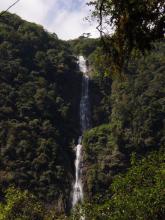Explore Bhutan Cultural Library

This collection contains essays on various genres of oral traditions in Bhutan, as well as other cultural subjects. Each text is linked to relevant places and subjects, such that users can explore the rich tapestry of Bhutanese culture through different media.
Texts in this collection
The list below includes texts from this Collection’s Subcollections.
A brief summary of the eight main manifestations of Guru Rinpoche according to the Bhutanese perspective.
An explanation of the history and significance of Bhutan's national day, celebrated annually on December 17th.
Gyatongpa, literally ‘one with eight thousand’ is one of the most common books found in traditional Bhutan. It is the Perfection of Wisdom Sutra in Eight Thousand Verses also called Aśṭasāhasrikāprajñāpāramitāsūtrain Sanskrit.
This piece was initially published in Bhutan’s national newspaper Kuensel in a series called "Why we do what we do".
We offer fragrance or incense because it is very pleasant object for the olfactory organ. It is an offering made to the olfactory organs of the Buddha and the Bodhisattvas. Beside the incense sticks and powders that they lit called dug poi, Bhutanese also offer scent or perfume and ointments
This piece was initially published in Bhutan’s national newspaper Kuensel in a series called "Why we do what we do".
An overview of the jyoyig Bhutanese script, its possible origins, and its relationship to other scripts used in Bhutan.
The ritual of kago, which most Bhutanese asks a lama to conduct, is a terrifying mode of enlightened activity through which the lama commands a malevolent spirit to stop harming a particular person.
This piece was initially published in Bhutan’s national newspaper Kuensel in a series called "Why we do what we do".
An abbreviated history of the Kagyur's translation into Tibetan, including its contents and main editions.
The offering of butter lamp is the offering of wisdom and light of knowledge to eradicate darkness or ignorance. Therefore it has a crucial place in Bhutan’s daily rituals.
This piece was initially published in Bhutan’s national newspaper Kuensel in a series called "Why we do what we do".
The structure and perceived functions of the kharamshing, built to counter the effects of gossip, slander, and other malicious speech.
A summary of the types and nomenclature associated with Bhutanese riddles.
A view of the Könchoksum, or Three Jewels of Buddha, Dharma and Sangha, from the Bhutanese perspective.
A synopsis of kuchoe (sku mchod) and gonzog (dgongs rdzogs), two commemorative events held in honour of a deceased master.
A description of langkor, traditional songs sung as oxen plow the fields.
A summary of the philosophy of karma (las) and ley judre (las rgyu 'bras) from the Bhutanese perspective, including its causes and its consequences.
A description of the contents and performance of Lebey, a concluding song and dance meant to cultivate auspiciousness.
A summary of the functions and significance of Bhutanese temples.
A problematization and discussion of the origins and applications of the name Lhomonkhazhi, or Southern Land of the Four Approaches.